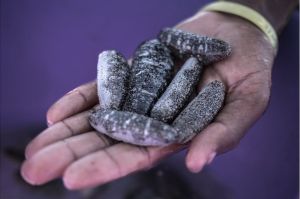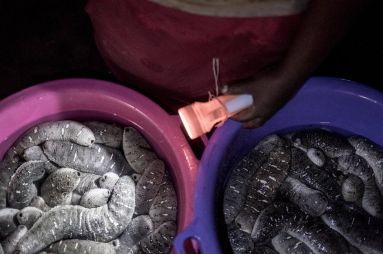
Honestly, I had never heard of Sea Cucumbers before, and at first when I heard about it, I thought “cucumbers grow in the sea?” Later I found out that sea cucumbers are actually a marine species belonging to the same family as that of the starfish… and so I had to highlight this photo-journal article on the BBC website, especially as it pertains to Madagascar, the big Isle. Enjoy some excerpts below.
====
In much of the Far East, sea cucumbers are a delicacy, fetching a high price for their purported health benefits.
In Tampolove, a tiny windswept village of mud huts and sandy paths squeezed between the coast and the forest in south-west Madagascar, they have provided a major boost to the local economy and environment. The delicacy is transforming the lives of people who have typically earned no more than a dollar a day, while at the same time helping to alleviate the pressure on marine species.

Sea cucumbers belong to the echinoderm family, along with starfish and urchins, and come in all shapes and sizes. They spend their days buried in silt, emerging at night to feed, sifting through the sediment for particles, a practice that provides an essential filtration service that benefits the wider ecosystem. Yet in recent decades rampant overfishing to feed demand in Asia has left wild sea-cucumber stocks declining around the world.
The sea-cucumber farms in Tampolove are part of a scheme to protect the environment and improve lives in this neglected part of the country. In 2004 the local community, with the support of a British NGO, Blue Ventures, came together to decide what to do about the rapid decline in fish and octopus stocks in their coastal waters. They set up an association, comprising representatives from several villages on this stretch of coast, whose responsibility it would be to manage fishing and the environment. They called the protected area Velondriake, which translates from the Vezo language as “to live with the sea”.


I remember seeing sea cucumbers for the first time at a zoo when I was a kid. I thought they were veggies from the sea until I saw them move and realized they were animals. This is my first time hearing about sea cucumber farms and I didn’t know people ate them. If you put one in brine would it be a sea pickle then?
LikeLike
Haa ha ha…you got me Ospreyshire… I don’t know… but I know sea cucumbers are very prized in Asian cuisine…
LikeLiked by 1 person
Thanks for appreciating my humor, Dr. Y. Haha! I seriously didn’t even know that about sea cucumbers used as food elsewhere. That’s certainly not a thing in America even though I wouldn’t eat one.
LikeLike